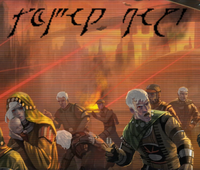Drudari-Ternary War
| Drudari-Ternary War | |||||||
|---|---|---|---|---|---|---|---|
| Part of the Pre-Assembly conflicts | |||||||
 The Bombardment of Teng | |||||||
| |||||||
| Belligerents | |||||||
|
Drudari Sphere |
Ternary Alliance Carasi pirates (alleged) | ||||||
| Commanders and leaders | |||||||
|
|
| ||||||
| Casualties and losses | |||||||
|
Non-Aligned | |||||||
Drudari-Ternary War, also known as the Grand War, was a galactic war that lasted from 6 BF to 1 IJ. Growing quickly from a border skirmish into a true war, for both sides a state of total war emerged. The two sides threw their entire economic, industrial, and scientific capabilities behind the war effort, blurring the distinction between civilian and military resources. Though disputed by Xyn historians, the Grand War is considered the deadliest conflict in galactic history, marked by x fatalities, many of whom were civilians. It included massacres, planetary bombing, unrestricted use of bio-warfare, and the use of strategies and weapons now outlawed by the Treaty of Ravnikor.
The Grand War changed the political structure of the galaxy. The Interstellar Assembly (IA) was established to foster intergalactic co-operation and prevent future conflicts; the former enemies, the Drudari Ecumene and the United Planets became the permanent members of its Elder Council, and were joined soon after by the Cosmic Hierophancy and the Seven Bright Ones
Chronology
Background
Pre-war events
Northward Expansion
-Thyssian expansion into the Pale
Course of the war
First Contact (6 BF)
Siege of Moj and Vože (6 BF)
Conquest of Serenity (5 BF)
Sôr'thes Offensive (5 BF)
Fall of Moj and Vože (4 BF)
Desolation of Teng (4 BF)
Xyn Awakening (2 BF)
Destruction of Ravnikor (2 BF)
Stalemate (1 BF)
Reclamation of Vože (1 BF)
Treaty of Amity (1 IJ)
Aftermath
Impact
Casualties and War crimes
Support for and Opposition to the war
Propaganda campaigns
United Planets
In the early stages of the war the United Planets focused mainly upon the themes of nationalism and heroism. The war was presented as an opportunity for a short and glorious adventure, and for Thyssians especially a way of bringing honour to one's house and tribe. The Drudari, still a relative unknown, were presented as a shadowy and unknown alien power seeking to tear apart the union and enslave the peoples of the United Planets. While many of these advertisements utilised military officers, including real figures such as High Commodore Rhon and Lord Tija, a great deal of them centred upon Saint Rholosh and the religious justification for the war.

As the war progressed and the hostilities continued to mount, propaganda in the United Cities began to shift towards focusing on the violent acts committed by the Drudari, particularly against the worlds of Teng, Moj and Vože. While violence as a concept was not an anathema to the Thyssians, religiously or ethically, the Drudari were framed as being unable to wield it according to Rholoshi concepts. Posters stressed the innate and bestial savagery of the Drudari, making them out as a non-sentient force, incapable of reaching Godhood through violence, that the United Planets had to overcome.
This new campaign played upon the Thyssian fears of extinction, a spectre which had haunted their race for centuries and before the war had almost become a forgotten fear. As the cause of the war were not made available to the general public, the Drudari were assumed to be attacking to either eradicate or enslave the Thyssians. The conduct of their campaign in the later stages of the war, and the propaganda framed around it, led the citizenry towards the idea that they were fighting a war to save themselves from extinction. This proved beneficial towards the United Planets war effort as it geared towards a total war.
